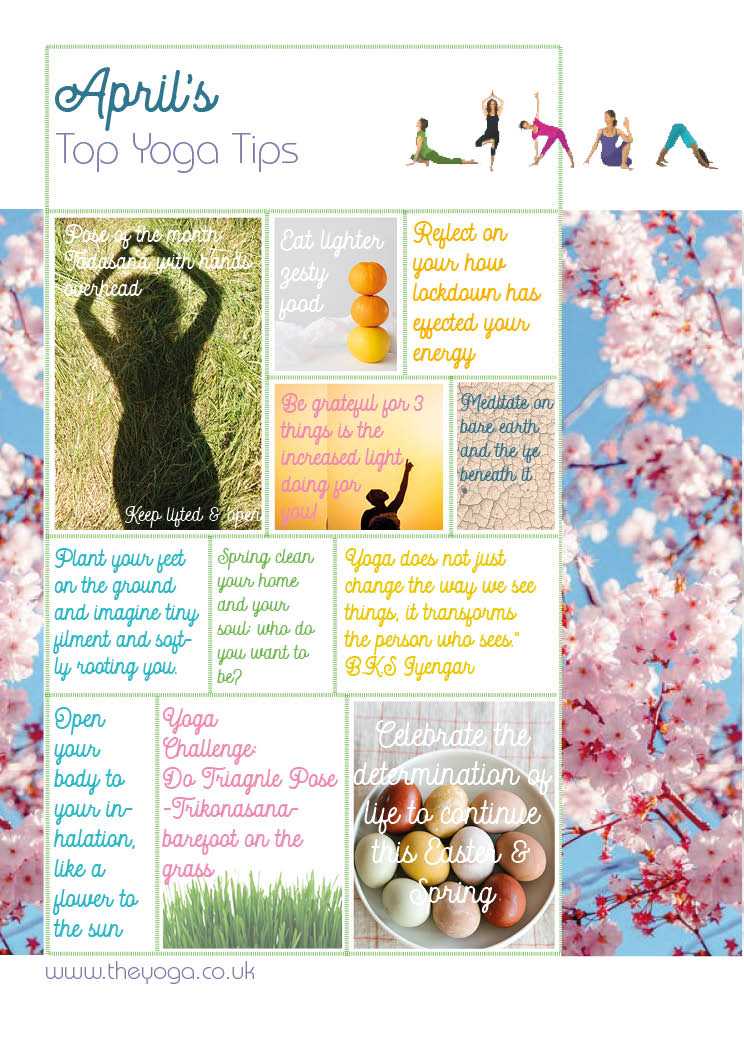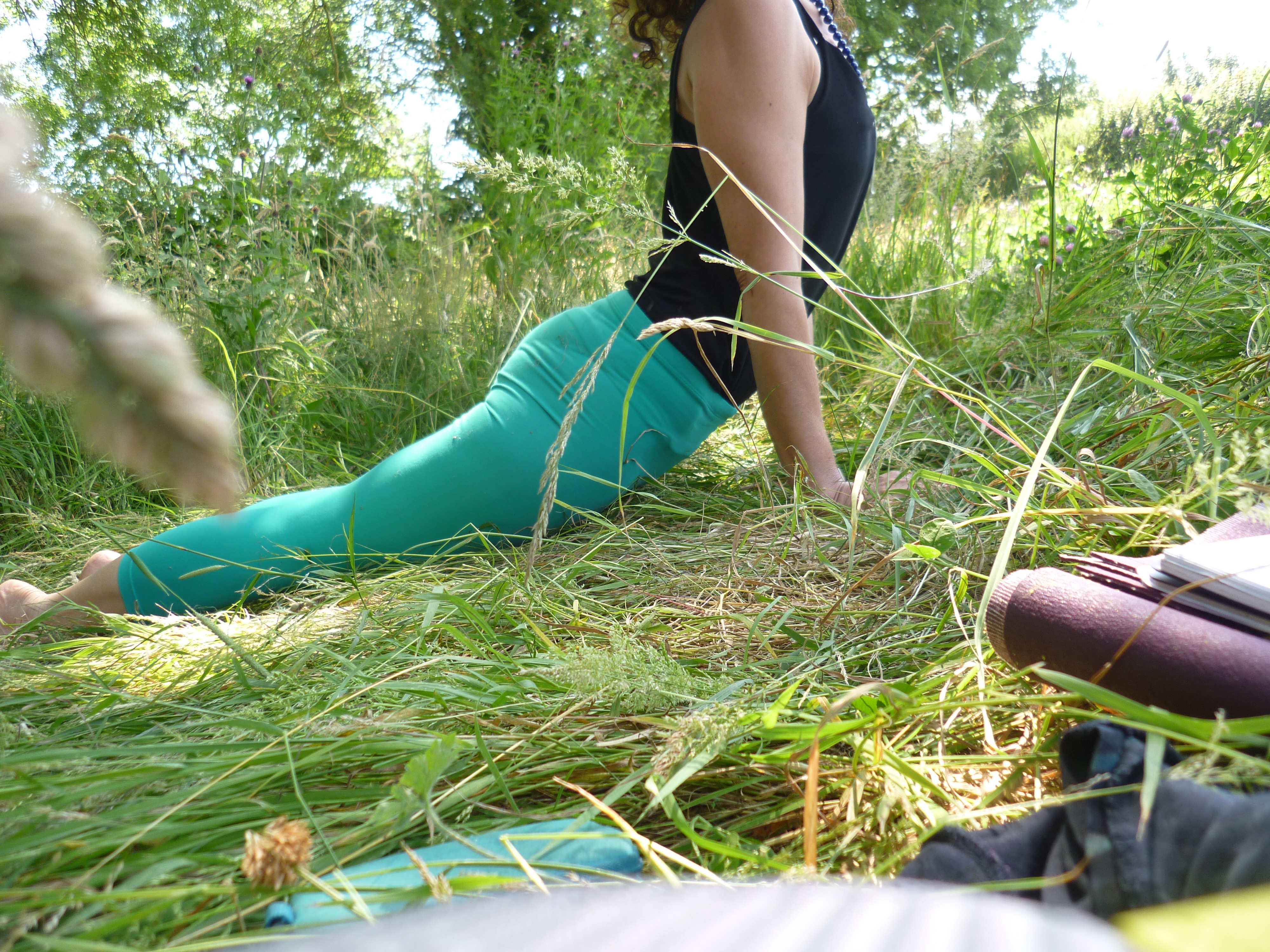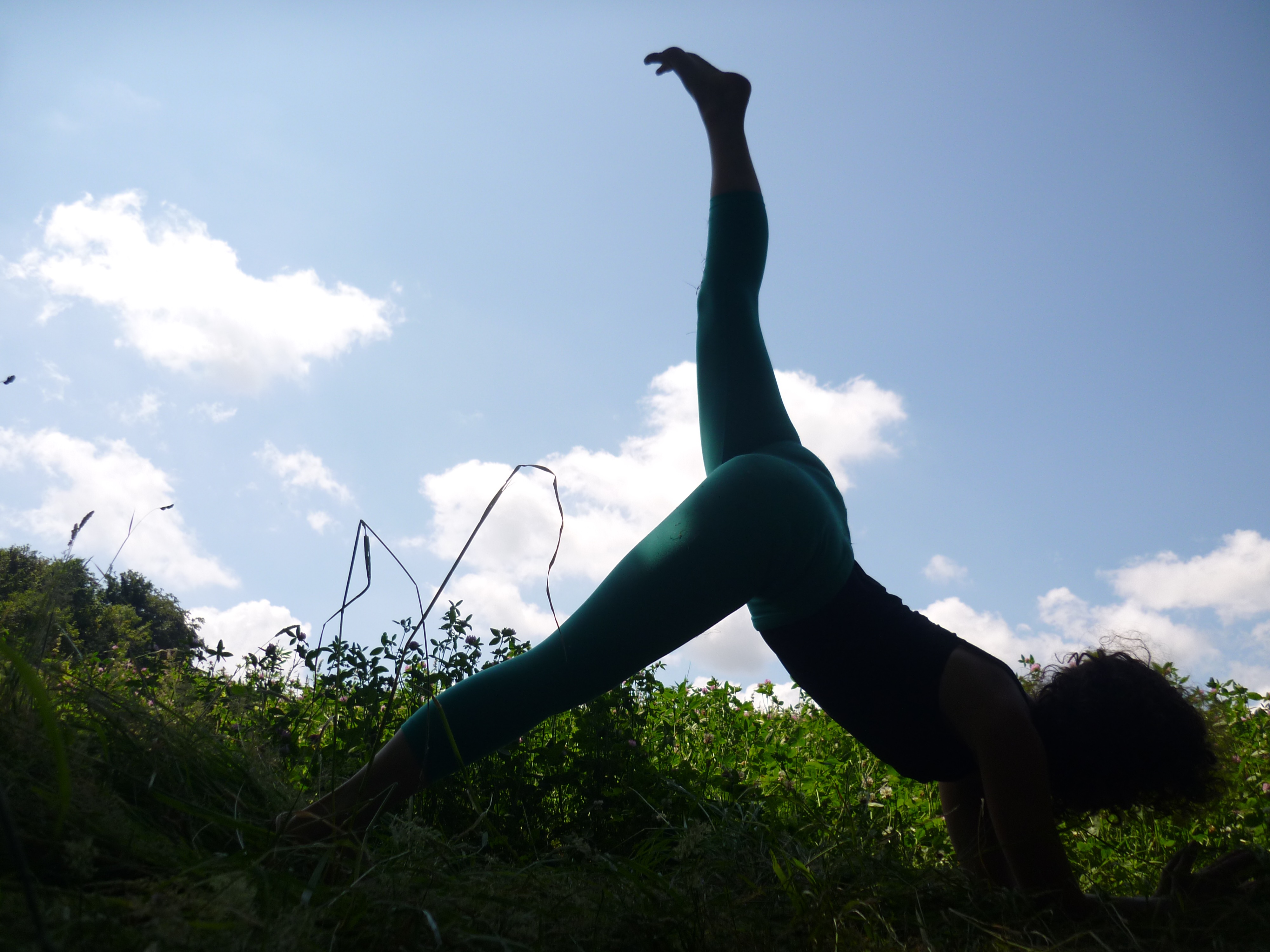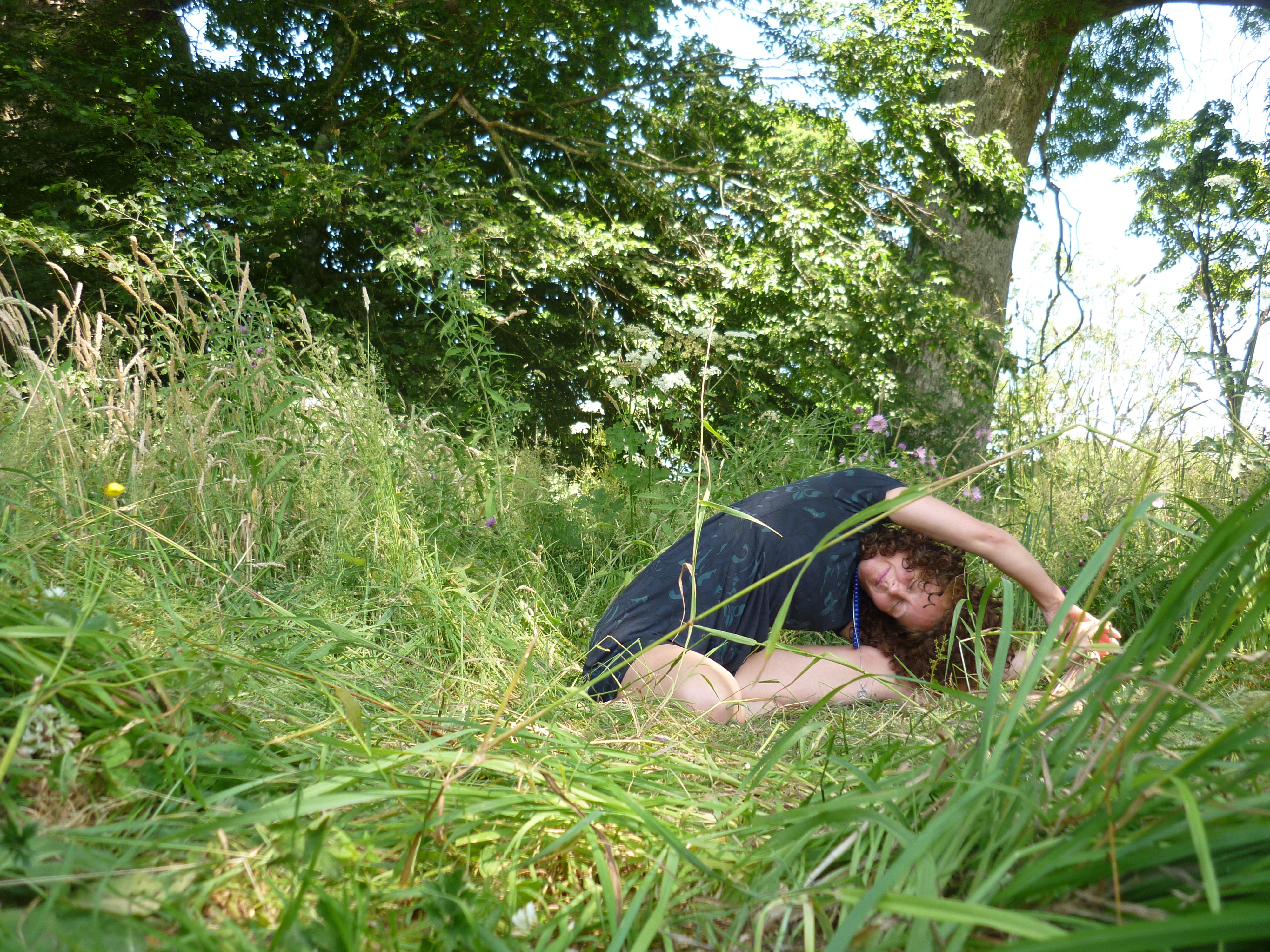blog
June’s Top Yoga Tips
Enoy some top yoga tips for June. Print it out, stick it in the suitcase or take it to the garden !

April’s Top Tips
Enoy some top yoga tips for April. Print it out, stick it on the fridge or just have a peek and save it for later!

Download Here
What is compassionate yoga?
 Can you be more self-compassionate during your yoga practice? Doing yoga can lead us into a process of self-judgement. Pushing it too far can lead to injury and an unhelpful state of mind. We need to learn how not to judge ourselves against others, and then how can we not being competitive with ourselves?
Can you be more self-compassionate during your yoga practice? Doing yoga can lead us into a process of self-judgement. Pushing it too far can lead to injury and an unhelpful state of mind. We need to learn how not to judge ourselves against others, and then how can we not being competitive with ourselves?
table of contents
- I want to do that pose
- the voices in your head
- when yoga goes wrong
- the middle way
- compassion & self-compassion
- emotional regulation
- a practice not a destination
- self-compassion for the pose you love to hate
I want to do that pose
Seeing a beautiful lush yoga pose can inspire and deepen your practice. It can bring a lift to your practice and help you explore your body. Of course these glorious images also have the possibility to be insidious. They can erode our practice into a series of pretty pictures and a ‘who is stretchiest’ attitude. If these thoughts just made you more aware of your vulnerable places, your unmet aspirations and your inner demon it could be helpful. But for most of us it takes us away from yoga, away from the very thing were practising. Poses become static, held, forced and in terms of energy lifeless. A positive thought can easily slip into a hint of self-defamation. Look at these examples below and see if you can move negative thoughts to the positive ones.
| Positive | Negative | |
| Flexibility | OMG look at that back bend, her foot is near here ear, blimey! | I will never be able to do that pose. |
| Strength | Look at his muscles tone! | I’m weak, I couldn’t do that. |
| Emotional | Wow, doesn’t she look happy! | I wish I felt happier, life is tough right now. |
| Lifestyle | I bet she has a nice house/partner/kids. | Something about my life isn’t good enough. |
| Yogic Devotion | She must practice a great deal, she must be very committed and wise. | I just don’t have the determination, I’m losing out by my lack of determination. |
| Purity | What an amazingly Zenlike quality they have. |
I’m like a troll in compassion. [If you say this with a sense of humour and laugh it’s still the same thing… turning a positive into a negative] |
| Professional | She must teach a lot of people and earn a good living. |
I don’t like my job, it doesn’t feel meaningful. Or My classes are down, and I’m struggling financially. My classes won’t be as inspiring as theirs. |
the voices in your head
It is entirely normal to have thoughts going through your mind as your practice. You might wander into thinking about something to add to the shopping list, a recent disagreement. You might find yourself day dreaming of a wonderful thing you would like to happen, like having a hug or seeing a loved one. Our intrusive and lovely thoughts can be as unhelpful as the less positive ones. What is happening in both cases is that we are not entirely present. Our chitta, or mind stuff, is out of balance with our body. When your thoughts, or chitta, judge your yoga it stops your yoga for being as valuable, it decreases its effectiveness and power. Thoughts might go along the lines of:
| Bigging yourself up | Smashing yourself down | |
| Flexibility | I am so rocking this pose. | If I work at this next time… |
| Strength | I am moving lower into this pose than ever before. | I just can’t do it. |
| Emotional | I feel so calm right now. | My thoughts are going crazy, this is just gymnastics if I can’t control my mind. I am so bad at yoga. |
| Yogic Devotion | I am living yoga. | I’m just a cruddy human making a mess of things. |
| Purity | My practice is so effortlessly pure right now. | I think I can smell my armpits. My thoughts are negative. I’m ruining this pose. |
| Now and then | In 2 months I will… | I used to be able to… |
when yoga goes wrong
Yoga like any discipline can go wrong. Yoga is built upon a series of tenents or rules which when obeyed bring one closer to enlightenment. While the yams and niyamas can be a helpful structure or guide to life, they can take yogis ‘to the dark side’. Quoting the Upanishads, lecturing others on non-violence or vegeatarianism can be dogmatic and abusive. Yoga fanatics are some of the most challenging as they do it with apparent kindness and care for others. When you find yourself sure that someone else is not upholding yoga disciplines it’s a sure fire warning sign that you’ve left your inner balance This is a great place for deeper growth and self-compassion.
the middle way
The middle way involves becoming more present, when the process is more interesting than our thoughts. It involves being so interested in what you’re doing that your thoughts untangle a little and you become aware of sensations and movements in the body without the positive or negative thoughts. This is the path of neutrality of thought, but an amplified awareness of the body and sensations. We become less attached to the outcome and more interested in the moment. The middle way unfixes thoughts. Thoughts about how another person is doing yoga, or how you rate your own performance become less important and instead there is space to notice and feel.
compassion & self-compassion
Compassion can bring to mind images of really lovely people doing super nice, empathetic things for another and thereby reducing suffering. It could be spending time and validating another person or it could be acting and providing something for them. Self-compassion is where we acknowledge and work with our own suffering. And yet when we talk of self-compassion often this is thought of as rather narcissistic behaviour where we navel gaze excessively.
Self-compassion has been shown to:
- Reduces anxiety,& stress
- Increases motivation
- Increases resilience particularly during times of stress
- Improves sleep and immunity
emotional regulation
According to recent research we have 3 main systems
- Protect – detects threats ‘better safe than sorry’. It involves: amydala, adrenalin & cortisol.
- Drive – motivates us to get resources. It involves: nuclus alccumbens, dopamine
- Soothe – promote bonding and soothe distress. It involves: prefrontal cortex, opiates, oxytocin,
These systems need to be balanced for us to experience wellbeing. Too much drive and not enough soothing can make us workaholics. Too much soothing and not enough drive could lead us to overeat and drink. In our society its normal for our ‘Protect’ system to be overactive. It goes hand in hand with self-criticism. To rebalance this we need to up our ‘Soothing’ system, self-compassion and yoga both do these… so how powerful can they be together?
a practice not a destination
Compassionate yoga is a practice not a destination. You won’t one day have suddenly ‘got it’. It will develop over time, and your can practice, so it will evolve but there is no ‘end point’. Very differently to the yamas and niyamas there are no set rules, no good and bad, but a movement towards. By practising compassionate yoga we build the strength we need in good times that will be particularly useful to us when the chips are down.
‘weave your parachute while you’re on the ground’ Adriana
At first it might feel messy and that you don’t quite get it, when this happens practice in the mess. Be kind to yourself, just as you are kind to others. You can ‘fake it until you make it’ and pretend to be wise, kind and understanding of your struggles. As you practice speak to yourself from your inner wise person, or your best friend.
self-compassion in the pose
There are some poses we don’t gel with and maybe avoid or resent. Use this practice before the pose and then during the pose to meet it in a new way.
- Acknowledge what you dislike about the pose: My leg gets tired, my breathing goes hard, I wobble, I feel ungainly.
- Remind yourself suffering is a part of life but unnecessary in yoga practice: Suffering is human, we all suffer, but I don’t need to suffer now. I can adapt the pose, ask for guidance or leave it out and focus on my breathing.
- Ask to be kind to yourself: May I find my peace with this pose, myself, my body. May I feel my feet on the floor. May I learn to let go of the pose and focus on my breath and spirit.
summary
When we practice self-compassion we emotionally regulate ourselves and boost our self-soothing capacities. We can do this by watching our thoughts, our chitta, whether its about yoga philosophy, our practice or a particular pose. When I teach I bring self-compassion into the practice. When you are at home you can do the same. Soothe yourself into balance by accepting you and your yoga in the now. You are good enough right now, just as you are.
Want to find a compassionate yoga class?
If you liked this blog why not try:
Yogic Sweet Treats: healthy nutritional treats to keep you happy inside and outside
Uujayi breathing: a video and blog to help you breath your way to calm
Does it really matter if my toes point outwards?: a blog about orlfing, fascia and toes position
Yogic Sweet Treats
 Everyone loves. A little sweetness in their lives and yogis are no different. So how can you support your health, maximise your nutritional input and enjoy life?
Everyone loves. A little sweetness in their lives and yogis are no different. So how can you support your health, maximise your nutritional input and enjoy life?
Healthy eating improves immune functioning, gives a range and balance of nutrients and micro nutrients required, maintains a good weight and helps your teeth. Reducing sugar can help you stabilise your blood sugar, reduce addictive eating, reduce weight, improve gut bacteria to help everything from your digestion to your skin. There is alink between your micro biome and your emotional health – so reducing sugar, once past the challenging phase can leave you feeling better in yourself as well.
Sattvic
One of the tenants of yoga is pure and energyful. A sattvic diet consists of fresh fruits, vegetables, legumes, dairy, whole grains and nuts. Some foods are too rajasic: stimulating, meaning they make the body too excited and prone to anger like coffee, garlic, fizzy drinks, spicy and fried food. Tamasic foods are sedatives, they dull and defocus: stale or reheated food, sugar, alcohol, meat, fish, mushrooms and blue cheese. Here are some easy ways to increase your saatva.
How to reduce sugar easily
- Go Savoury: Reduce sugar by indulging in the stuff you love: oatcakes and cheese, seaweed thins and crisps
- Watch Your Dopamine: The kick of excitement your get is of imagining the treat rather than actually eating it… so if you are decisive you can get the same kick for ½ a donut to a whole one.
- Half it: If you want chocolate brownie eat half a serving
- Rule of thumb: Use the rule of thumb to decide on the size of treat to have each day. That will help limit the damage.
- Buy in small packets: Biscuits like Biscoff, come in small packets which can help you enjoy a small treat without the temptation to keep going.
- Small tins: Buy mini tins of coke or fizzy drinks to limit the amount you have.
- Eat enough real food: Make sure you eat enough complex carbohydrates so that you are not hungry and drink enough water so you remain hydrated.
Natural sweeteners
- Honey: Use ½ to 2/3 of honey instead of sugar in recipes. Another option is to 1 cup of honey = ½ to 2/3 cup of honey, ¼ teaspoon of baking soda and reduce liquids in the recipe by ¼ of a cup. Reduce your oven temperature by 25 degrees Fahrenheit. Honey reduces allergies and has anti inflammatory properties.
- Agave: Not unlike honey but plant based so great for vegan and low impact planet friendly folk.
- Stevia: A plant based white sweet powder that adds sweetness but not much volume.
- Artificial sweeteners: Avoid artificial sweeteners. They seem like a ‘free lunch’ but contribute to weight gain even with ‘no calories’ and increase toxic load in the body.
Highly nutritious and low sugar
- Lotus fruit: Pick your favourite plate and spend time enjoying making a beautiful plate of prepared fruit. Or serve a bowl of fruit and nuts with knives and candied almonds asa healthy makeshift pudding.
- Fruited scones: Scones, jam and cream are delightful. Use a chia seed compote in place of the jam.
- Lemon crepes: Make crepes and serve with loads of lemon and a drizzle of honey.
- Melon with cointreau: a family favourite, simple and delightful.
- Fruit jelly;
- Love Pots: Grated apple, oats, fruit juice, nuts and dried fruit, left to steep overnight in small pots in the fridge, delicious! Maybe add ¼ teaspoon of cinnamon and some pureed apple.
- Fruit Crumble: add apple juice rather than sugar and use a granola cereal for the topping)
- Yogurt Knickerbocker Glory: use plain yoghurt, layers of rolled oats and mixed berries with a drizzle of honey or maple syrup to top it off.
- Honeyed fruit: Stew fruit in water and later add honey just enough to melt the honey in and to keep its full benefits.
- Fruit purees: Add fruit juice to stew your fruit in and then purree down, lovely with flaked almonds. Use as a sauce or swirl two together for fun.
- Fruit lollies: Swirl yoghurt with a little glycerine (to make it less hard) and frozen fruit to create marbled lollies.
- Baked apples: Core your apple and stuff with rainsins, bake in the nven and serves with custard.
- Try Om Bar: Delightful raw chocolate without sugar : )
Alternatives
| Instead of | Try |
| Chocolate biscuits |
Digestives with thinly sliced and a sprinkle of cinnamon Dried fruit: try a little espresso cup as a way to serve |
| Biscuits |
Potato scones or crumpets with butter Toast & marmite |
| Your normal amount |
Half it! Eat a portion the size of your thumb |
| Fruit juice |
Water infused with lemon or cucumber Herbal tea: try ginger root and lemon cooked up |
| Fizzy drinks |
Tiny tins of tonic An espresso cup of fruit juice Gin and fizzy water, lovely! |
| Icecream |
Homemade mango and cardamom sorbet Frozen vanilla yogurt or gelato |
| Puddings |
Plain live yoghurt, plain, honest you’ll grow to love it eventually Apples stuffed with raisins and baked |
| Jam |
Cook frozen fruit with chia seeds Pureed fruit with lemon juice |
| Sugar | Honey, Agave or Stevia |
Hard Core
Going without sugar is a great option as a reboot to the system. It might take a week, a month, a year or a decade – it depends on your system and how much it is needing a rest.
Stages:
- Sugar free: Have a period of 4 or 5 days completely sugar free each week for a month. If you notice some benefit try a whole month.
- Sweet free: Have a period of 4 or 5 days completely sugar and sweet things free (including fruit, honey, agave, dried fruit. If you notice some benefit try a whole month.
Keep it Real!
I’m a great fan of having strong rules and also breaking them. This is the know your standards and aims and expect them, and also give space for real life. Whether it’s sugar, yoga practice or finances, Id encourage you to have a clear plan, and then give yourself moments of childlike freedom and joy to do what feels good. Too much of this and you’ll likely end up with a massive credit card bill and matching belly, but not enough and you just get a bit uptight and unhappy. So find your balance.
No Results Found
The page you requested could not be found. Try refining your search, or use the navigation above to locate the post.



